Over the past several months I have read a number of articles saying that white rice is not good for us and that we should not eat it. After spending some time looking at the available nutritional information I feel comfortable saying that, for most people, two or three serves of rice a week will not negatively impact health.

Let me say that another way; the maximum amount of rice we should be consuming each week is three serves. A serve of rice is ½ a cup (100g) of uncooked rice. When cooked it makes 1 ½ cups of rice.
Recently I asked a young client about his diet. He said that he ate rice two or three times a day, and that it was sometimes the only food he ate. I asked him if this was because he could not afford to buy other food. He said that he could afford to buy other food but that it was easier just to cook and eat the rice. The main problem with this is that rice does not provide all the vitamins, minerals and essential amino acids that our bodies need; and this young man’s health had significantly deteriorated due to the lack of variety in his diet.
Rice in itself is not the problem. The problem is the amount of rice that is being consumed; portion sizes are too large and consumption too frequent. For many people rice has become the main food in the family diet. Reducing portion size and limiting rice to three serves a week will help create a better balanced diet.
Ideally we should replace most of the rice in our diets with lots of greens and other bright coloured vegetables. Adding a serve (150g) of local root crops is a good option for those that need extra kilojoules. When we do eat rice, we should stick to a maximum of a single serve (1 ½ cups of cooked rice). Personally, I choose to limit my rice portions to ½ a cup of cooked rice as I have a relatively sedentary job and do not need the extra kilojoules.
For diabetics, pre-diabetics and people trying to lose weight it is best to remove rice from their diets. Eating rice results in a large spike in blood glucose levels; this is dangerous for diabetics and those at risk of developing diabetes. Rice is high in kilojoules and should be avoided by people trying to lose weight. Even brown rice and basmati rice, which have less impact on blood glucose levels, still have a high glycaemic load, are high in kilojoules, and should be avoided if possible.
One of the main arguments I hear in favour of rice is that it is cheap. Based on the current price of rice, one serve (100g uncooked) costs approximately 15VT. This week, I bought a large basket of Kumala at the markets and worked out the cost of one serve (150g peeled, uncooked) to be 18VT, making it very close in price to rice and a good replacement option. Kumala, and other root crops, are higher in vitamins and minerals and have more fibre than rice. It is also possible for many of us to grow our own root crops, making it an even more affordable option.
Wherever possible replace rice with lots of greens and other brightly coloured vegetables. Food variety is one of the most important factors in a healthy diet and promotes good health.

Comments